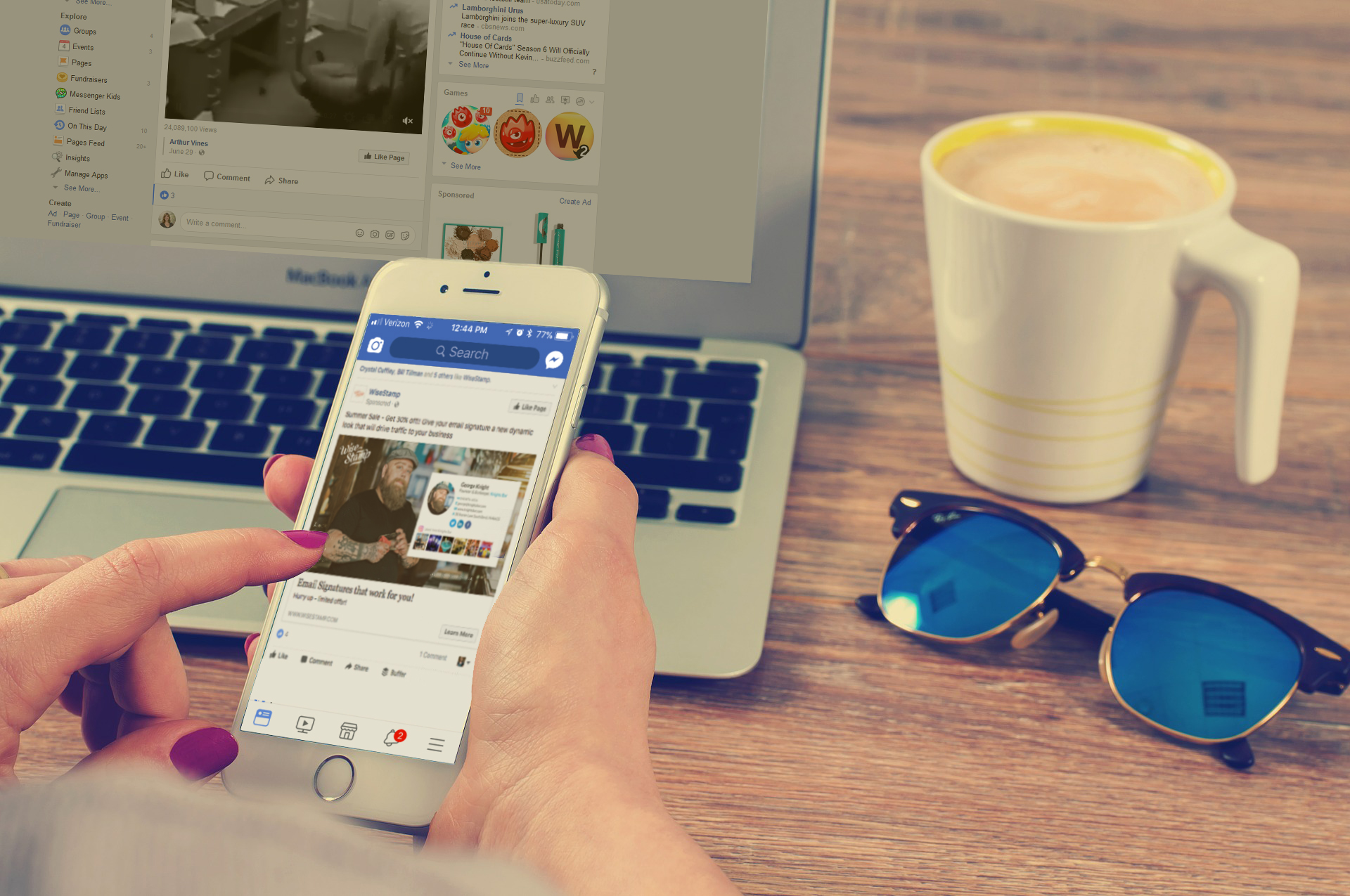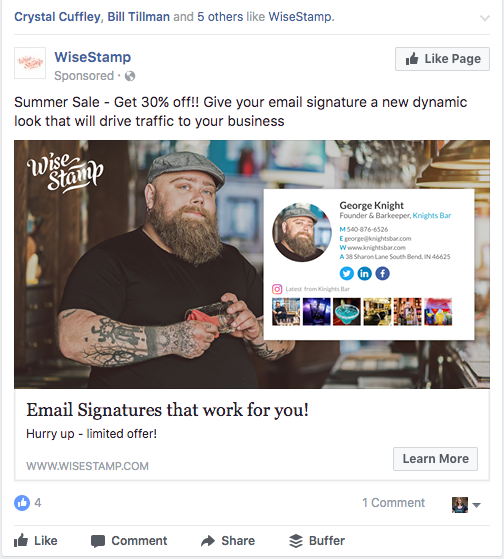Where’s the hook? A Facebook Ad Journey Review from the Awareness stage
Welcome to the first Facebook Ad Journey review in my #FunnelVision series. This series walks you through the Customer Journey from the perspective of the customer or prospect: in this case, me. (Hi.) and measures it against my Customer Journey Storytelling Mashup Model. The goal is to measure the journey as a story. This month’s Facebook ad focuses on a brand I didn’t know and a product I didn’t realize existed : Wisestamp.
Not being aware of the brand or product puts me, as an unknowing prospect, at the very top of the funnel. You can see the Customer Journey Storytelling Mashup Model I’m building these reviews from.
I’m not aware of the product or the brand, so this journey starts at the beginning : Awareness + The Hook.
[Tweet “The first stage goal is Awareness + The Hook in the new Customer Journey Storytelling Mashup Model.”]
At this stage, I likely don’t know there’s a problem to be solved or a solution to solve it. I don’t know the brand or its products or why I should care. Tall order of storytelling ahead of WiseStamp here, to make their ad relevant enough to interrupt my day. How does their journey do?
On Facebook, I am targeted with this ad while on my mobile phone:
So the story kicks off with Wisestamp telling me I can get a dynamic new email signature that will drive business and it’s on a Summer sale, so I can get 30% off right now.
I’m going to assume WiseStamp has done their homework. They know their personas and if a female tech geek who works in marketing, shops online (a lot), and loves popcorn is among them? Bullseye. So let’s also assume they’ve done a bang-up job of choosing their audience in FB. Check.
I’m starting this journey as an Awareness stage, so it’s their job to hook me: make me curious, make me want to know more, make it relevant to a pain point in my life.
[Tweet “An awareness ad needs to make the customer curious.”]
What are your thoughts when you see this Facebook ad? Would you click? Tell me in the comments.
Reviewing the ad
I like George’s signature: showing what’s different here is extremely important. Otherwise “email signature” is something we all know we can do in our email programs. So I’m going to want to know why I would pay for something different.
And it’s on sale. 30% off for the summer. (I started watching these ads over the summertime.) In the text, it includes Urgency Offer words: Hurry up – limited offer! But it doesn’t state how limited, when it’s up.
So I click on the ad to discover more–which means the ad has done a good job of making me curious. It’s important to note that this doesn’t move me out of the Awareness stage. Clicking on the ad does not mean I’m actively considering this. It means I’m curious. I still have questions I need answers to and the landing page needs to provide them. When you’re building your ads, realize where your prospect or customer is in this journey and feed that. Curiosity is a great thing for marketers.
The landing page that I get lists at the top of the screen: 30% off! (and I didn’t apparently grab a screenshot of this page and can’t seem to get back to it.).
The header of 30% off was followed pretty close by a an urgency deal offer :
Offer ends in 2 Days, 4 hours and 42 minutes.
Here’s the thing: for these urgency offers to have maximum impact, I need to trust the company that’s telling me I have to act now. I’m kind of ornery like that. I’ll be tempted to see what happens at the end of the countdown, to know if this is a true urgency offer or just a ploy to make me move today. I’ve seen too many companies try an urgency deal repeatedly, which means it’s a psychological ploy to get me to act — not a true offer. So putting in an urgency offer right at the top of the Awareness : Hook stage is risky, in my opinion. I’d love to hear from marketers who have used it and how it’s worked?
At the Awareness stage, you have to build trust first and the Why second.
[Tweet “At the Awareness stage, you have to build trust first and the Why second.”]
So I’m not sure a heading showing a discount is the best approach.
The questions I have:
- Who are you?
- Why are you offering this?
- Who else has used it?
- What benefits have they seen?
- Why would I pay for this?
- Why do I need it?
And that’s just to name a few. At the Awareness + The Hook stage, you have to convince me that I’m willing to give you time.
This landing page however doesn’t give me a lot of information. The only option is the “Get It Now” button, which takes me right to an upgrade to awesome plan page with a form and a request for my Credit Card information.
>
That’s a major leap to expect someone to take right off the main page. So in two clicks from an ad and not knowing the brand, I’m expected to give them my credit card and sign up for a monthly account. If this current journey were a story character, it would be a great suspense villain: “Hi, you don’t know me, but you can trust me. Here is my car, why don’t you get in?”
So where did I land on the journey?
A customer journey story at my level should have fueled my curiosity and helped me see where I have a pain point here, even one I haven’t realized exists. This journey should have started me on a new path of discovery, one that may or may not bring me back to the brand. To steer me their direction, it should have answered my questions, and if I’m not going to make a purchase then, left me with things to ponder and hopefully a way to let the company keep the conversation going.
What might have worked? Offering me a download of how email signatures impact brand perception, which would require my email address to get. Not a case study at this point, but think of it as providing little snacks for the journey. You’ve fueled my journey forward and ensured that I will take at least part of it with you. When you provide me with good information, you build my trust and your authority.
Right now, this ad journey doesn’t kick off a good story. The leap from Facebook ad to “Pay now” is too fast, there isn’t enough information for prospects to see how this is beneficial to them.
This story needs a little more bait on the hook to draw me in.
Next in this series
Be sure to check in with part 2 of this post, coming soon where we’ll go over some other elements of this customer journey with Wisestamp from the Consideration stage.
[su_box title=”Note about these Journey Reviews” style=”soft”]
Marketing itself is a journey. We’re constantly learning, changing, growing and adjusting based on what works and what doesn’t. All of the journeys I review and comment on are one snapshot at one moment in time of that marketing journey. It could be the first iteration or the twentieth. It’s likely that they’ve changed, grown and tested new elements since I started screenshot-ing their ad journeys. These posts aren’t intended as anything other than a way to observe and learn from a marketing moment in time.
In fact, if you’re the marketers involved in this journey, I’d love to hear from you. I’d love to hear where you are now and how your ad journeys are performing.
These journey reviews are not a review on the brands, the products and services represented.
This is just. about. the. journey.
[/su_box]










I’ve tried Wisestamp. Liked it, but never paid for a subscription. I never got passed the. “Why should I pay for this” stage.